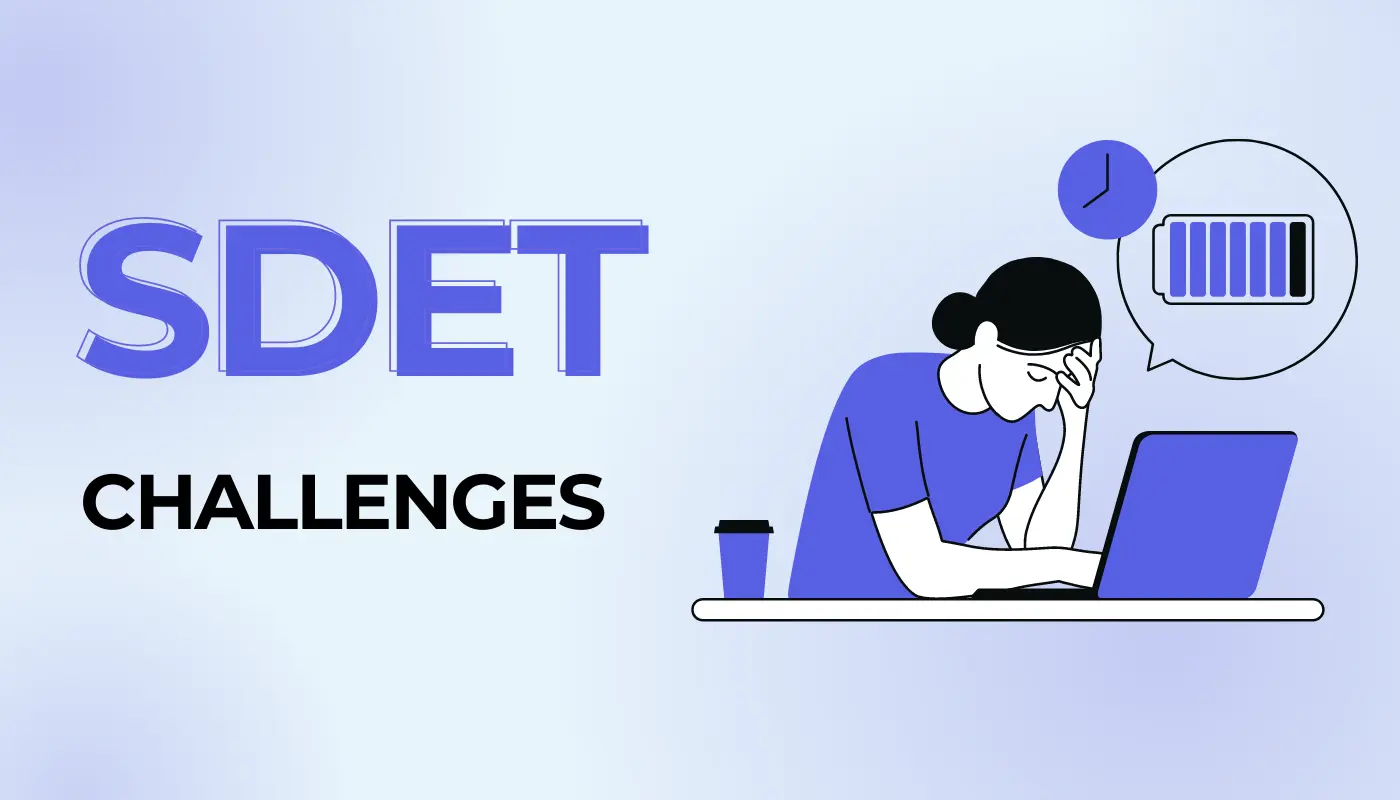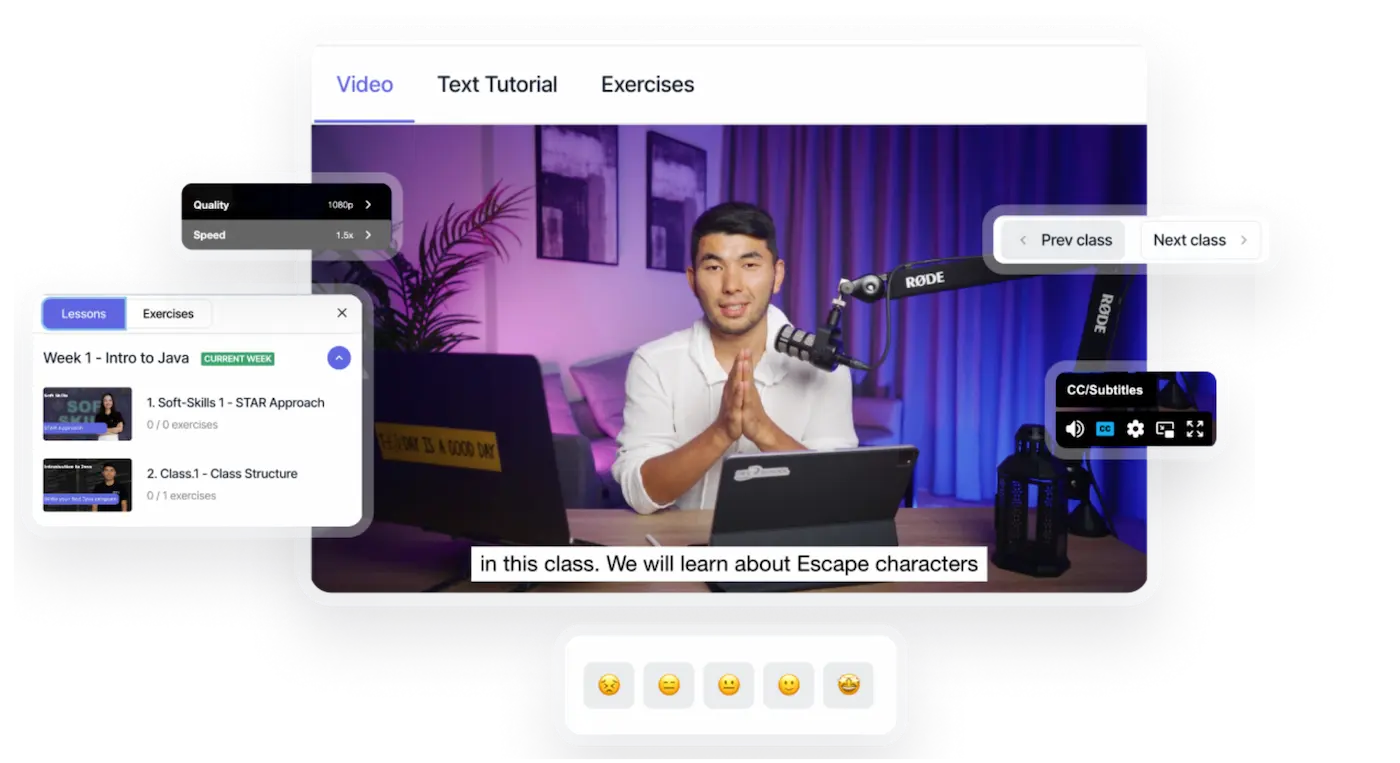SDETs commonly face several challenges that include managing a dual focus on development and testing, adapting to new technologies, ensuring comprehensive test coverage, and integrating automated tests within continuous integration/continuous deployment (CI/CD) pipelines. All these challenges require them to be adept in both coding and testing while mastering in-demand software development practices and tools.
Its true that the role of an SDET becomes challenging as it requires a deep understanding of both software development and testing principles. Factors like rapid changes in technology, a mix of manual and automated testing approaches, and the high expectations for product quality—contribute to the complexity. SDETs can balance all this only if they acquire a unique set of skills with constant adaptation.
Let’s discuss some of the major challenges that SDETs face every now and then. We’ll also provide you with quick insights into ways to overcome such challenges in real-time.
Challenges That SDET Engineers Faces Now and Then
Challenges are an inherent part of the role of Software Development Engineers in Test (SDETs). In fact, the majority of SDET challenges stem because of their unique position at the intersection of software development and testing.
We can say that the dual responsibility of coding and quality assurance places a high demand on SDETs. Just to maintain both depth and breadth in their technical expertise.
So—the major challenges that SDETs face include:
Inability to Keep Up with Rapidly Changing Technologies
SDET professionals often struggle to stay current with rapidly evolving technologies, programming languages, and testing frameworks.
Let’s say you are working on a project using Selenium for web automation. But it suddenly requires you to shift to Cypress due to client requirements. You won’t know what to do if you are unfamiliar with Cypress, right? This becomes challenging as you fail to keep up with the rapidly changing tech stack over time.
The rise of cloud computing and the ongoing complexity of software systems are pushing SDETs to acquire skills in cloud-based testing environments and automation tools. What would you do if you were unable to master it? You’d be left falling behind.
Can’t Balance Automation and Manual Testing
There’s no doubt that balancing the right mix of automation and manual testing is tricky. That’s because each has its place in the software testing lifecycle.
For instance, you are a part of an SDET team that relies heavily on automation. However, the critical bugs are slipping through because certain edge cases are only accessible through manual testing. This can be quite challenging for your SDET career if you fail to follow a hybrid approach for testing. Both automation and manual practices are important.

Lack of Communication With Cross-Functional Teams
This is quite common for SDETs to effectively communicate with development, product management, and design teams.
Let’s say you come across a critical bug in the late stages of the development cycle. However, you struggle to convey the urgency and impact to the development team. This would lead to delays in resolution. All because of lack of communication among teams.

Don't know where to start your tech career?
We are here for you! Schedule a free call with our consultant for personalized advice on achieving your learning goals
High Expectations for Test Coverage
There is often a high expectation to achieve near-complete test coverage. This can be really unrealistic and stressful for SDETs.
Let’s suppose that there is pressure to have 95% test coverage right before a major product launch. You’d do anything to achieve the desired results, right? However, unfortunately, this would lead to nothing but rushed testing processes and potential oversight of critical test cases.

Inflexibility in Tool Selection
Organizations sometimes mandate the use of specific tools regardless of their suitability to the task at hand. This can surely hinder testing effectiveness.
For instance, you are forced to leverage a particular automation tools that does not support the mobile platforms predominantly used by their applications. That’s problematic and challenging, no?
Or let’s suppose you required to use outdated bug tracking software that isn’t compatible with the latest versions of other software tools you use. This can also lead to significant delays in problem reporting and resolution. All while further compounding inefficiencies and increasing the risk of errors slipping through the cracks.

Unstable Environment Setup Issues
If there are frequent changes in the testing environments, it can lead to inconsistencies and delays in testing.
It’s like you may face daily issues because the test environment is not consistently updated with the latest codebase—causing test failures. Or imagine you are required to test an application that relies on specific third-party APIs. One day, you find that all requests to these APIs are failing. After hours of debugging, you discover that the API keys in the test environment were not updated to match those recently changed in the production environment. This oversight not only wastes time but could also divert attention from other critical testing tasks.
Inadequate Documentation and Insufficient Requirements
Compiling documentation can be tough for SDETs due to the complexity of software systems, rapid development cycles, and frequent software updates that require constant revisions to documentation.
Unfortunately, incomplete, unclear, or missing documentation and project requirements can severely impact the software testing process.
Let’s say you receive partial requirements for a new feature integration. This would lead to multiple assumptions and reworks in the testing phase, no? Without comprehensive documentation, you might fail to design tests that fully ensure the feature functions correctly in all scenarios. Ultimately, increasing the risk of bugs in production.
Furthermore, inadequate documentation can prevent you from fully understanding the software’s intended behavior. If the documentation does not clearly explain how a new feature should interact with existing components, you may not test these interactions thoroughly. So, that would make you overlook critical integration issues, wouldn’t it? This gap in testing coverage can lead to significant technical debt and increase maintenance costs over time.
A Way Down to Overcome SDET Challenges
- Continuously update skills through online courses, webinars, and workshops. For instance, you can enroll in a tech-focused program WEDEVX SDET bootcamp. It can help you master emerging technologies such as AI-driven testing tools or advanced automation frameworks like Robot Framework.
- Develop a clear testing strategy that balances manual and automated testing. Let’s say you map out which features require the rigor of manual testing (like user experience aspects) and which can be efficiently tested through automation (like data validations).
- Improve communication with cross-functional teams. For example, you can schedule bi-weekly sprint retrospectives or stand-up meetings with project managers and developers. All just to discuss ongoing issues and synchronize testing priorities.
- Set realistic test coverage goals. You can use tools like TestRail to define and track coverage metrics, and engage in risk-based testing. It can help you focus on the most business-critical functionalities first.
- Advocate for a flexible tool selection process. You can conduct a quarterly review of testing tools and their alignment with project needs. It’s better to prepare a comparative analysis of tools like Selenium VS Cypress. All while illustrating how one might benefit specific project requirements over the other.
- Maintain stable and consistent testing environments: Implement version control practices for test environments using Docker to manage and replicate exact states of your software across different testing stages.
- Ensure all project documentation and requirements are complete and clear. You may utilize platforms like Confluence to maintain a centralized repository of project documentation. All while encouraging regular updates and reviews by team members to clarify any ambiguities.
Final Words
SDET professionals are not safe from challenges. In fact, their journey is even more challenging than developers. Not only do they need to balance between coding and testing, there are various aspects they are required to cover.
It is suggested to focus on improving test automation skills, ensure close collaboration with associated teams, and leverage continuous integration and delivery practices. All while staying updated with industry trends and best practices.
SDETs must cultivate a mindset of continuous learning and embrace agile principles to overcome all challenges like a pro.
Frequently Asked Questions
What are the overall impacts of challenges on SDETs if they are not addressed?
If the SDET challenges are not adequately addressed, the consequences can be severe. SDETs may experience burnout, decreased productivity, and reduced job satisfaction. In fact, the quality of the software products may suffer, which in turn, leads to increased bugs and security vulnerabilities that can affect user satisfaction and damage the company’s reputation. It is necessary to overcome all challenges like rapid technology shifts, balancing development with testing, handling flaky tests, and budget constraints. Only then SDETs will be able to work properly and ensure the success of software projects.
How can SDETs manage the balance between development and testing duties?
SDETs can effectively manage their dual roles by prioritizing tasks based on urgency and importance. All while fostering strong collaborations with both developers and quality assurance teams, and adopting agile practices. Time management enables SDETs to stay adaptable and responsive to the needs of the development lifecycle. Indeed, this balance ensures that both development and testing phases receive the attention necessary for producing high-quality software.
How can SDETs effectively implement automated tests in CI/CD pipelines?
SDETs should work closely with DevOps teams to effectively integrate automated testing in CI/CD pipelines. This allows them to ensure that testing is a seamless part of the deployment process. Their collaborative approach makes sure that automated tests are reliable, relevance is maintained to the deployment, and everything is executed efficiently. It is suggested to leverage modern tools and technologies like Docker to create consistent testing environments as this can enhance the effectiveness of testing in CI/CD contexts.











